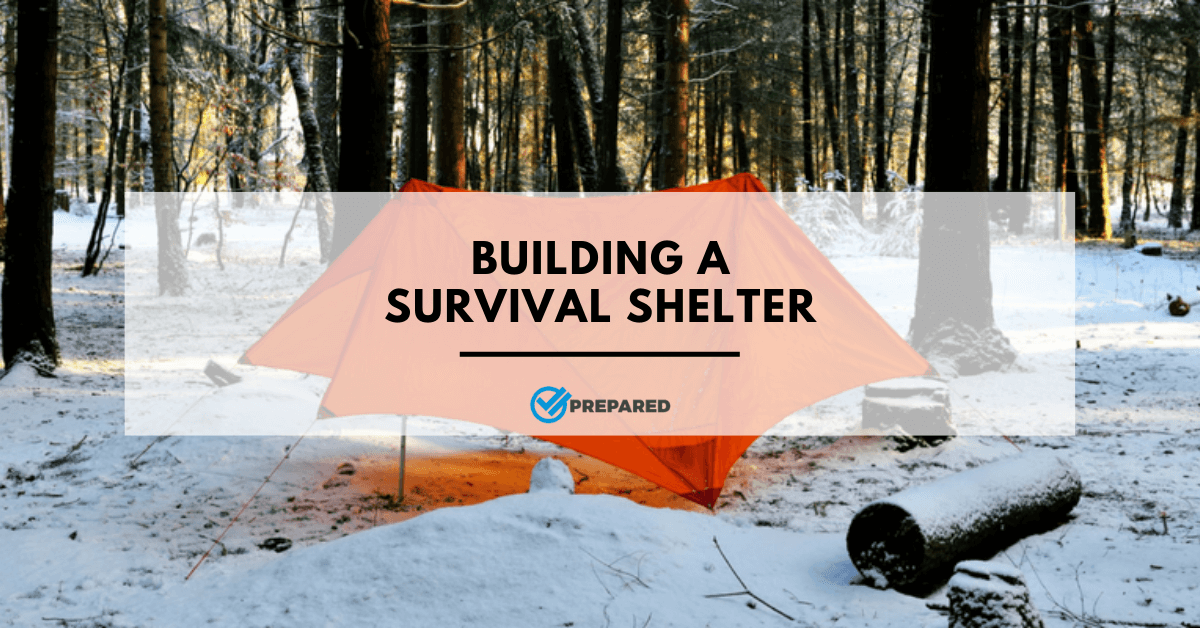When the sun is going down, and you need shelter, it is important to know what to do to protect yourself. In cold or rainy weather, shelter from the elements must be your top priority. Hypothermia is the top killer in survival situations and can affect you in any climate anywhere in the world. In this article, I will cover your survival shelter priorities and provide a few examples of simple shelters you can use in a hurry.
Survival Shelter Priorities
There are four priorities you need to consider when looking for shelter:
Insulation from the ground – This must be one of your first points of focus. The ground will draw a great deal of heat from your body. It is suggested that you have a bare minimum of four inches (10 centimetres) of packed insulation below you with an ideal amount being closer to ten inches (25 centimetres). You can create insulation with leaves, dried grass, a sleeping pad, a structural bed, a hammock, spruce boughs, or artificial materials.
Overhead protection – If it happens to rain and your shelter does not keep you dry, your body will reach hypothermia 20 times faster. Most people do not know that, just like the ground, the open sky also draws warmth from your body. Also, direct exposure to the sun can cause death by dehydration in just a few hours. A solid, waterproof roof is vital in most cases.
Protection from the wind – Strong winds can also draw warmth from your body. Anything you can build or natural structures will help reduce this problem.
Surrounding insulation – By having thick walls, you can keep your body heat inside your shelter. The walls will also better protect against predators, the wind, blowing rain, and insects.
Survival Shelter Types
When you are in a hurry and need a survival shelter, often using existing structures is your best bet. Existing structures such as caves, rock faces, large trees, and snowdrifts are ideal to give your structure strength, insulation, and windproofing. Here are some fast shelters that can get the job done.
Caves – Caves are one of your fastest options and are waterproof, but you must be cautious. Caves may be home to other animals including large predators, snakes, and deadly spiders. Look for tracks or fur before settling in. Also, be cautious of large fires in caves as the heat can break rocks and cause a cave-in.
Spruce trees – In deep snow, spruces can be a lifesaver. The thick fronds will keep the ground underneath dry, and dead needles that fall below offer insulation. The deep snow will help block the wind. The branches above will help with light rain, but anything heavy would be an issue.
Snow Caves – Another option in deep snow is to use a drift to dig a cave. This can protect you from the wind while holding in your body heat. Snow has about half the insulating qualities of fibreglass insulation. Start by shoving six-inch (15 centimetres) long sticks fully into the snow and all over the top of your drift. Dig down to the base of the drift and start hollowing out your cave. Keep your door just large enough to get in and out. If you run into a stick while digging, immediately stop to prevent a collapse. If you can, build two-floor levels with the top-level long enough on which to sleep. The cold air will stay down below, and you will be warmer while you sleep.
Tarp/Emergency Blanket – There are dozens of waterproof and windproof shelters you can build with a tarp or emergency blanket in just minutes. This is why I carry one with me as often as possible. A lean-to shelter is the easiest. Simply secure a ridge pole between two trees at about five feet high. Then stretch the tarp across it and attach the corners. Stake the bottom two corners into the ground leaving the tarp at a 45-degree angle. (You can also use sticks at a 45-degree angle and then pile debris on top for an all-natural version.)
Consider time, effort and warmth
There are dozens of other more advanced shelters that you can build in a survival situation. However, there is two major consideration with other designs. One is that you are more likely to run out of daylight without finishing the survival shelter. The other is that you are more prone to build a shelter that is too large. The larger the space inside the shelter, the harder it is to keep it warm. If you simply focus on your basic needs and use what nature provides, you will do just fine.

Chris was born and raised in South Africa and has worked in the field of risk management, organisational resilience, and business continuity for more than a decade. During his career he has seen how private and public sector organisations benefit from effective risk management and business continuity planning. Realising that families and communities can also benefit from the same tools, methodologies, and principles, he started Prepare with Foresight.
Prepare with Foresight was launched to assist individuals and families to have the peace of mind that they will be able to recover from and successfully adapt to the consequences of adverse events.

